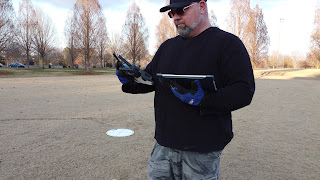Choosing a Take Off and Landing Zone - 001
I was shooting video at the beach, not on the beach but at a large inlet waterway with a scenic bridge, a very nice setting to say the least. The Visual Observer and I had scoped out the area earlier in the day and found a good LZ, a turn-off area just before the bridge. This was perfect for parking with a good amount of space for the drone to take-off and land. The idea was to get a video of the inlet at sunset (a good time to remember the :30 minutes after civil twilight regulation).
Since it was a flight that would be over water I was concerned about all the video footage that was already on the video card and decided it was important to download it to a safe place. The risk you run with this type of mission is that if you lose your drone all of the videos on your card can get destroyed along with the drone, so it’s best to download footage after every mission (or switch cards). Easier said than done.
Parking seemed fine at first because it was just us and a broken down pick-up truck, that was until a couple of other vehicles pulled over to watch the sunset too. I was imagining several more vehicles haphazardly pulling in and blocking the LZ. There was a sectioned off area near us that would ensure no encroachments to our area but time was a wasting, sunset in 5 minutes.
Our thoughts turned to having an alternate landing site, always a good idea, just in-case we couldn’t access our original landing site, or if an issue came up where we had to land short of our LZ. There were a few options, land in the area with the protection of the two guard rails, land in a flat marsh area (not ideal), or fly across the road to an adjoining thin strip of grass that would require a good amount of precision and possibly be a distraction to drivers. Interestingly, I noticed a great alternate landing site after the fact when reviewing the video. Note to self, pay attention to these opportunities while shooting.
Speaking of distractions and passing drivers, drones can be a distraction to drivers so be careful as to flying too low and close to a road, not to mention flying directly over a passing car. I like to have a buffer, like our parked vehicle or natural features to minimize the rubber-necking effect.
As mentioned drones can be distracting to drivers but drivers, and the passengers can be distracting to drone teams when they stop and ask questions. While we handled just a couple of easy questions from onlookers, this emphasized the point of designating the Visual Observer (VO) or other person not flying the drone to handle questions. It’s worth noting that telling curious folks, in a courteous way, that you will answer questions after the flight.
Remember, it’s important to debrief the good and the bad of every flight. Discussing only the bad comes with the chance of the conversation becoming just another complaint session. Discussing the positive things is as important because you can build on them making the next flight safer, efficient and better all around.
TC Freeman is the Chief Instructor for the RemotePilotAssociation.com (RPA) and has a passion for helping recreational and commercial drone pilots learn to fly and earn FAA commercial Remote drone Pilot certification through live, hybrid or self-study courses.
Join us for our annual JUNE-JULY New Membership “OPEN HOUSE,” a FREE-no obligation bi-weekly webinar where we discuss drone business, certification and re-currency. Email us to RSVP.
#drone, #dronephotography, #dji



Comments
Post a Comment